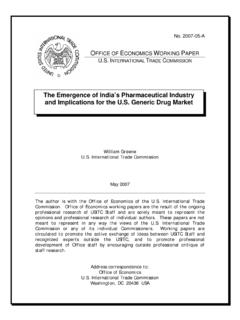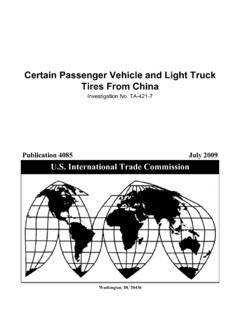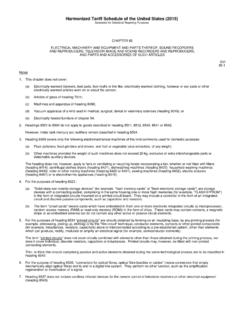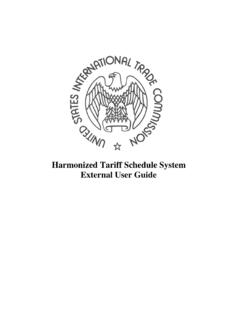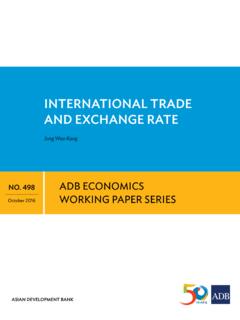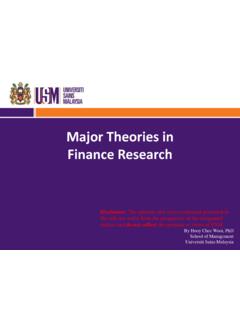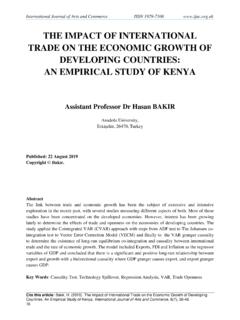Transcription of How Do Exchange Rates Affect Import Prices? Recent ...
1 How Do Exchange Rates Affect Import Prices? Recent Economic Literature and Data AnalysisNo. ID-21 OFFICE OF INDUSTRIES WORKING INTERNATIONAL TRADE COMMISSIONC athy L. JabaraOffice of International Trade CommissionMay 2009 Cathy Jabara is a Senior Economist with the Office of Industries of the International Trade of Industries working papers are the result of the ongoing professional research of USITC Staff andare solely meant to represent the opinions and professional research of individual authors. These papers arenot meant to represent in any way the views of the International Trade Commission or any of itsindividual Commissioners.
2 Working papers are circulated to promote the active Exchange of ideas betweenUSITC Staff and recognized experts outside the USITC, and to promote professional development of Officestaff by encouraging outside professional critique of staff research. Address correspondence to:Office of Industries International Trade CommissionWashington, DC 20436 USAHow Do Exchange Rates Affect Import Prices? Recent Economic Literature and Data AnalysisCathy L. JabaraMay 2009 Office of International Trade Commission500 E Street SWWashington, DC 20436 Judith Dean and Jose Signoret of the Office of Economics provided valuable commentsincorporated into the paper.
3 The author thanks those in attendance at a seminar at the Trade Commission in March 2009 where valuable comments were received. Theviews and opinions expressed are those of the author and do not necessarily reflect the views ofthe International Trade Commission or any of its DO Exchange Rates Affect Import PRICES? Recent ECONOMIC LITERATURE AND DATA ANALYSISC athy L. Jabara*May 2009 Office of International Trade Commission500 E Street SWWashington, DC 20436 ABSTRACTAn important issue for industry competitiveness is the extent to which Exchange rate changes Affect the pricesof imported goods. In theory, a weaker dollar should raise the cost of foreign goods for consumers andreduce the demand for imports, while boosting foreign demand for goods.
4 However, betweenFebruary 2002 and July 2008, the dollar fell by almost 35 percent against a broad index of foreign currencies,while the prices of Import commodities showed much less change. This paper reviews some of the recenteconomic literature as to why Import prices change so little relative to a change in the value of the discussed include pricing-to-market, currency invoicing, and cross-border production. Usingdata for 1999 to 2008, the paper estimates Exchange rate pass-through to Import prices for all importsexcluding oil, and consumer goods, and for imports from Japan, the European Union (EU), Canada, and theNIEs (Taiwan, Singapore, South Korea, and Hong Kong).
5 The Exchange -rate pass-through estimates werefound to be low ( for all imports excluding oil and for consumer goods). The highest estimates ofbilateral Exchange -rate pass-through were for imports from Canada (.33) and the EU (.24), and the lowest forimports from Japan (.12) and the NIEs ( ). An Exchange -rate pass-through was also estimated for prices from China for a small number of observations from mid-2005 to 2008, the period when theyuan fluctuated against the dollar. The estimated Exchange -rate pass-through of must be taken with adegree of caution, due to the small sample (14 observations). *The views and opinions expressed are those of the author and do not necessarily reflect the views of the Trade Commission or any of its Commissioners.
6 Contact information: Phone 1-202-205-3309and e-mail 1 DOL, BLS Import price indexes. (accessed January, 2009).2 IntroductionBetween February 2002 and July 2008, the dollar fell by almost 35 percent against a broad indexof foreign currencies, while the prices of Import commodities showed much less, or very little change. For example, the Department of Labor (DOL), Bureau of Labor Statistics (BLS) price index for allimports excluding petroleum rose by 20 percent, while the price index for imported consumer goods roseby a mere 6 Economists have generally found that prices of imported goods do not usuallyrespond with one-to-one to changes in the Exchange rate.
7 This paper will explore some of the reasons whysome Import prices change so little relative to a change in the value of the dollar. In theory, a weaker dollar should raise the cost of foreign goods for consumers, therebyreducing demand for imports, while boosting foreign demand for goods by making exportsmore price-competitive abroad. Thus, a weaker dollar is usually considered to be a key mechanism forincreasing the international competitiveness of producers. However, economic research suggests thatthe link between the Exchange rate and the prices of imported goods is more complex, with fluctuationsaffecting Import prices to varying degrees, depending on the industry.
8 These studies show that theeffect of an Exchange rate change depends on firms price-setting behavior. This paper examines Recent literature and data on the effects of Exchange Rates on traded goods inthe United States. This is an important topic for industry analysis because of the importance offluctuations in Exchange Rates for industry competitiveness. Moreover, with the value of the dollarcurrently reversing course and appreciating against a number of currencies, information on how exchangerate changes Affect production and prices is important to understand future impacts of Exchange rateson trade. 2 The price indices examined usually exclude the price of oil, due to its volatility.
9 Some studies also exclude semiconductorsand computers, arguing that price determination is different for these industries relative to other consumer goods. 3 Mishkin (2008). Mishkin s analysis is based on the work of Marazzi, Sheets, and Vigfusson (2005) and Marazzi andSheets (2007). On the other hand, Hellerstein, Daly, and Marsh (2006) argue that, although declining, the change has not beenvery significant. 4 Ihrig, Marazzi and Rothenberg (2006) estimated an Exchange -rate pass-through coefficient for the G-7 countries (Japan,United States, Italy, Germany, France, United Kingdom, and Canada) of for the period from 1990-2004.
10 5 These are the three main explanations cited by Mishkin (2008). See also Campa and Goldberg (2002) and Marazzi andSheets (2007).3 Exchange rate studies usually focus on the rate of Exchange -rate pass-through-- the impact of achange in the Exchange rate on prices in the importing country. Pass-through is considered complete when the response is one-for-one , when a 1 percent change in the Exchange rate results in a 1 percentchange in the Import price. A number of Exchange -rate pass-through studies have shown that pass-through to Import prices2 is quite low, and some argue that it has declined in Recent Inaddition, pass-through to Import prices in many major trading partners has also been estimated to be less than one, even if somewhat higher than in the United There are three prominent explanations of why Exchange -rate pass-through might be low:5(1) exporters price to market by lowering or raising their profit margins to offset the effects of theexchange rate change.


